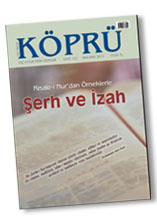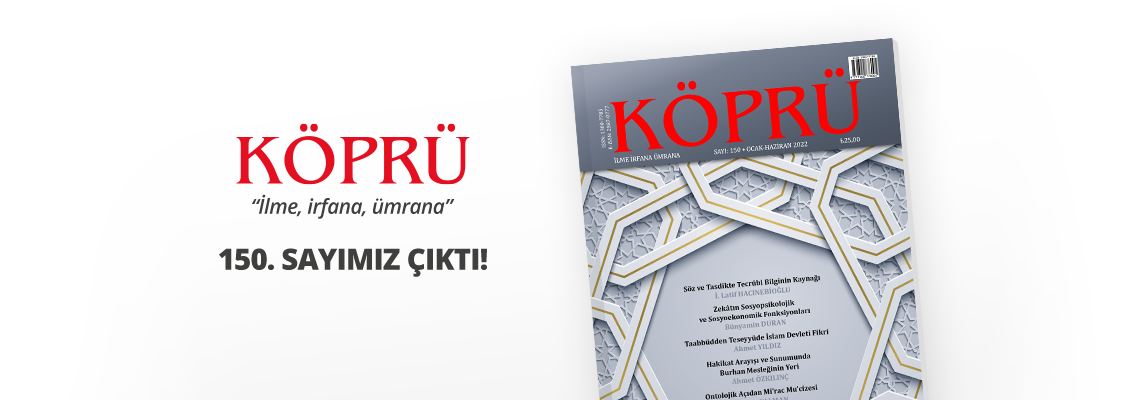Köprü Anasayfa

Risale-i Nur’dan Örneklerle Şerh ve İzah
"Bahar 2013" 122. Sayı
-
Interpretation and Explanation Through Sample Studies From Risale-i Nur
Editorial
The subject of simplifying, the focal point of recent discussions made about Risale-i Nur Works brought up the topics like the characteristics of the language, the style and methodology of Risale-i Nur once more. The file that we studied in the previous issue, “The Interpretation of Risale-i Nur” aimed at preserving the spirit and character represented by Risale-i Nur, but at the same time determining the study fields and methods to be followed for a better understanding of its messages. Due to the importance of the subject and the broadness of the area pointed out in the previous issue of the journal that shed some light on the topics mentioned, we continue to deal with the same subject in the present issue.
Therefore we continue to search the answers for a set of questions, that were asked in the previous issue, like “What subjects, concepts and areas are covered by the interpretation of Risale-i Nur? What are the basic features of the language of Risale-i Nur? What are the basic criteria that are to be used in the interpretation of Risale-i Nur? What should be the methods and ways of interpretation studies? What properties should be sought in the interpreters of Risale-i Nur? How can we evaluate the attempts of simplifying Risale-i Nur with the premise that it has not been understood? How can the map of concepts in Risale-i Nur be drawn?”
Bediüzzaman Said Nursî who witnessed the breakdowns concerning language, culture and civilization throughout the transition period from the Ottomans to the Republic, set up a special systematic thinking model of his own. The Quranic and Prophetic terminology, which is the essence of this systematic thinking, also constitutes the central point of Risale-i Nur. Understanding the characteristic properties and the truths of Risale-i Nur somehow depends on having a command of that language.
The words of Bediüzzaman, “Those who attend the circle of the lessons of Quran, even if they are the highest scholars (allameh and mujtahids) are only expected, with respect to the sciences of iman (ulûm-u imaniye) to carry out the tasks of interpreting, explaining and arranging the Words.” in fact determine the studying areas concerning Risale-i Nur, which do not include simplifying What are these areas, and how can the methods for studying in these areas be determined will be the basic questions being discussed in this issue of our periodical.
In short, the main content of this issue will be comprised of the criteria of the interpretation of Risale-i Nur, specification of the methods, determination of the language characteristics of Risale-i Nur, and the demonstration of the sample studies for the interpretation of Risale-i Nur. We consider that the 122nd issue, which outlines the specification of the map of meanings and the architecture of concepts in Risale-i Nur, the teaching of the Beautiful Names of Allah in Quran and their reflections demonstrated in Risale-i Nur, presenting samples of interpretation of the Works of Risale-i Nur like the Books of Sincerity, Debates, and Small Words and discussion of the question of simplifying will help the interpretation studies.
As we invite you to enjoy our periodical, we hope to address you in the 123rd issue with the presentations submitted in “The 8th Congress of Risale-i Nur: Said Nursi’s Understanding of Nationalism for Humanity and the World Peace.”
-
Risale-i Nur’dan Örneklerle Şerh ve İzah
Editör
Yazıyı okumak için tıklayınız... -
Interpretation and Explanation Through Sample Studies From Risale-i Nur
Editorial
Yazıyı okumak için tıklayınız... -
Risale-i Nur’un Şerh ve İzahı
Bünyamin Duran
Yazıyı okumak için tıklayınız... -
Risale-i Nur’u Şerh Çalışmaları Üzerine Bazı Öneriler
Recep Ardoğan
Yazıyı okumak için tıklayınız... -
Risale-i Nur’a Anlatım Haritası Yaklaşımı
Veli Sırım
Yazıyı okumak için tıklayınız... -
Risale-i Nur’un Şerhi Meselesine Bir Haşiye
Taha Çağlaroğlu
Yazıyı okumak için tıklayınız... -
Kur’ân’ın Esma-i Hüsna Taliminden Risale-i Nur’a Yansımalar
Mustafa Said İşeri
Yazıyı okumak için tıklayınız... -
Yaratılanı Yaratıcısı ile Barıştırmanın Bir Başka Unvanı
Cüneyt Eren
Yazıyı okumak için tıklayınız... -
Yaban(cı)laşma ve Küçük Sözler‘de Yaban(cı)laşan İnsan Tasvirleri
Mustafa Akça
Yazıyı okumak için tıklayınız... -
Risale-i Nur Orjinli Cemaat Tarzının Bir Kaynağı Olarak İhlâs Risalesi
İhsan Torunoğlu
Yazıyı okumak için tıklayınız... -
Risale-i Nur’un Şerhinde Bilim ve Fizik
Rıdvan Ziyaoğlu
Yazıyı okumak için tıklayınız... -
Risale-i Nur Metinlerinde Geçen Kavramların Açıklanmasında bir Durum Çalışması: ‘Lisân’ kavramı
Faruk Soylu
Yazıyı okumak için tıklayınız... -
Risale-i Nur’un Kavram Mimarisi ve Sadeleştirme
Yusuf Çağlayan
Yazıyı okumak için tıklayınız... -
Bir Karşılaştırma Örneği: Risale-i Nur’daki Meâl Örnekleri ve Mehmet Âkif Meâli
Ahmet Dursun
Yazıyı okumak için tıklayınız... -
Neşrinin 100. Yılında Münazarat Şerhi Denemesi: Metin ve Şerh
Levent Bilgi
Yazıyı okumak için tıklayınız... -
Risâle-i Nur’dan seçmeler
Bediüzzaman Said Nursî
Yazıyı okumak için tıklayınız...
